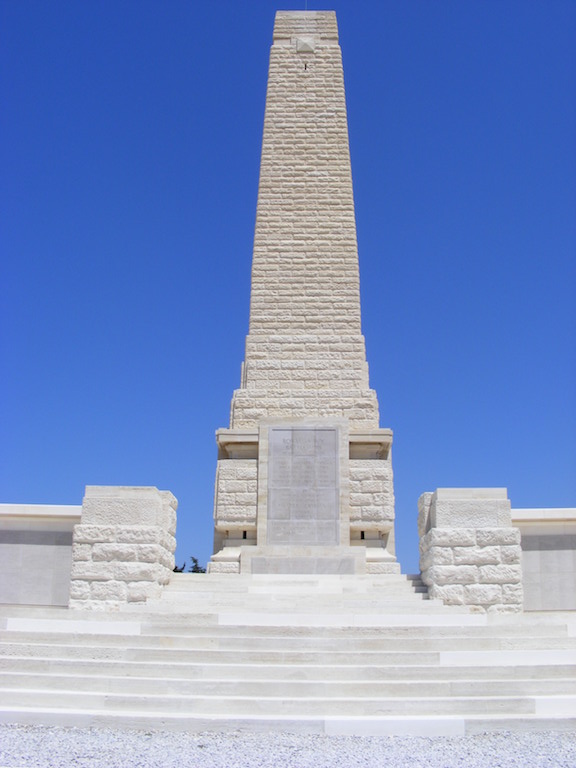Helles Memorial
- Country Turkey (including Gallipoli)
- Total identified casualties 20962 Find these casualties
- Identified casualties from First World War
- GPS Coordinates Latitude: 40.04545, Longitude: 26.17927
Location information
The Anzac and Suvla cemeteries are first signposted from the left hand junction of the Eceabat- Bigali Road. From this junction travel into the main Anzac area.
Follow the road to Helles, opposite the Kabatepe Museum, at 14.2 kms. take a right turn at the 'T' junction and at 14.3 kms. take the left fork. After a total of 22.8 kms, take a right turn to the memorial along a rough track 500m long.
The Helles Memorial stands on the tip of the Gallipoli Peninsula. It takes the form of an obelisk over 30 metres high that can be seen by ships passing through the Dardanelles.
Visiting information
The site is permanently open and may be visited at any time.
Please note that in the absence of a cemetery register, visitors are advised to locate the Grave/Memorial reference before visiting. This information can be found in the CASUALTY RECORDS within this page.
The Panel Numbers quoted at the end of each entry relate to the panels dedicated to the Regiment served with. In some instances where a casualty is recorded as attached to another Regiment, his name may alternatively appear within their Regimental Panels. Please refer to the on-site Memorial Register Introduction to determine the alternative panel numbers if you do not find the name within the quoted Panels.
For further information and enquiries please contact enquiries@cwgc.org
History information
The eight month campaign in Gallipoli was fought by Commonwealth and French forces in an attempt to force Turkey out of the war, to relieve the deadlock of the Western Front in France and Belgium, and to open a supply route to Russia through the Dardanelles and the Black Sea.
The Allies landed on the peninsula on 25-26 April 1915; the 29th Division at Cape Helles in the south and the Australian and New Zealand Corps north of Gaba Tepe on the west coast, an area soon known as Anzac. On 6 August, further landings were made at Suvla, just north of Anzac, and the climax of the campaign came in early August when simultaneous assaults were launched on all three fronts. However, the difficult terrain and stiff Turkish resistance soon led to the stalemate of trench warfare. From the end of August, no further serious action was fought and the lines remained unchanged. The peninsula was successfully evacuated in December and early January 1916.
The Helles Memorial serves the dual function of Commonwealth battle memorial for the whole Gallipoli campaign and place of commemoration for many of those Commonwealth servicemen who died there and have no known grave.
The United Kingdom and Indian forces named on the memorial died in operations throughout the peninsula, the Australians at Helles. There are also panels for those who were lost at sea, in one of the troopships sunk off Gallipoli. Over 20,000 names are commemorated on this memorial.
There are four other Memorials to the Missing at Gallipoli. The Lone Pine, Hill 60, and Chunuk Bair Memorials commemorate Australian and New Zealanders at Anzac. The Twelve Tree Copse Memorial commemorates the New Zealanders at Helles. Naval casualties of the United Kingdom lost or buried at sea are recorded on their respective Memorials at Portsmouth, Plymouth and Chatham, in the United Kingdom.


